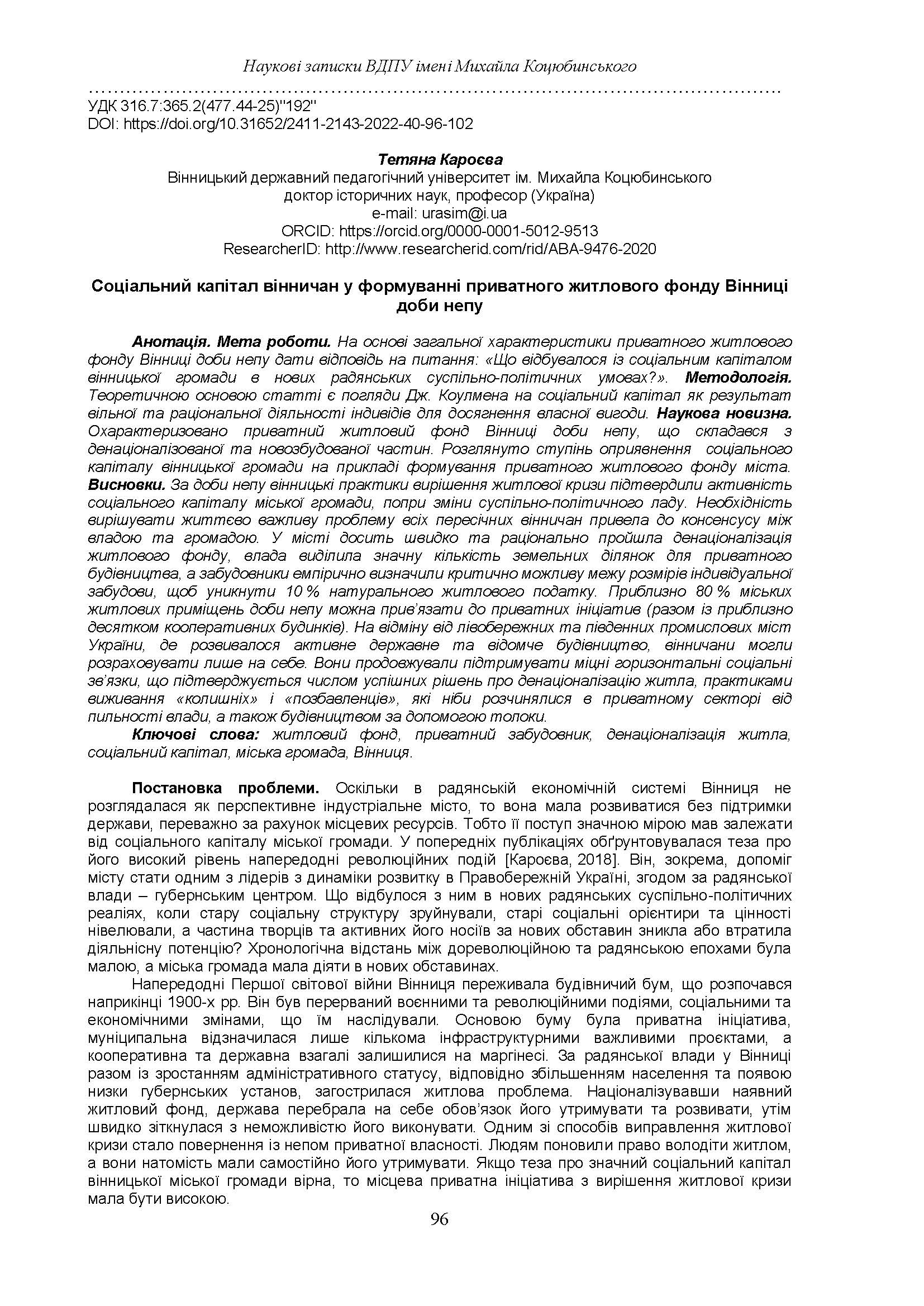Abstract
The study objective was to provide an answer to the question "What happened to the social capital of Vinnytsia town community under new socio-political conditions of the Soviet rule?" on the basis of general characteristic of the private housing resources of the town during the NEP. Methodology. The theoretical basis of the paper is J. Coleman's interpretation of the social capital as an issue produced by free and rational activity of individuals in order to achieve their own benefit. Scientific novelty. Private housing resources of the town of Vinnytsia composed of denationalized and newly built parts in the NEP period have been characterized. The degree of manifestation of the role played by the social capital of Vinnytsia community of the 1920s exemplified by formation of the private housing resources of the town has been considered. Conclusions. Practical activities of Vinnytsia community aimed at housing crisis surmounting during the NEP confirmed active role played by social capital of the town community in spite of changes in the socio-political system. The necessity of solving the vital problem that affected all ordinary dwellers of Vinnytsia resulted in a consensus between the authorities and the community. Denationalization of housing resources was carried out quite quickly in the town. The authorities allocated a significant amount of land plots for private dwelling construction and developers empirically determined the critically possible limit of private building size that made it possible to avoid 10 % housing tax in kind. As a result, about 80 % of the town housing premises can be attributed to private initiatives (including about a dozen of building cooperatives). Vinnytsia dwellers have only themselves to depend on as opposed to residents of industrial towns located in left-bank and southern regions of Ukraine where public and departmental housing was being developed actively. They continued to maintain strong horizontal social bonds, which is evidenced by the number of successful decisions on housing denationalization, the survival practices of "persons of the past" and incapacitated persons resided in private houses who seemed to flee from scrupulous attention of the authorities, as well as by implementation of collective methods of house construction.
References
Coleman, J. S. (1990). The Foundations of Social Theory. Cambridge, MA: Belknap Press of Harvard UP, 993 p.
Бируля, О. (1930). Архітектурна історія Вінниці. Вінниця, 68 с.
Борисенко, М. (2009) Житло і побут міського населення України у 20–30 рр. ХХ ст. Київ : Стилос, 356 с.
Городское строительство к 15-летию Октябрьской революции (1932). Советская архитектура, 5–6, 3–10.
ДАВіО – Державний архів Вінницької області.
Жилищный закон (1921): постановление СНК УССР от 1 нояб. 1921 г. Собр. узаконений и распоряжений рабоче-крестьянского правительства, 22, 641.
Инструкция о порядке отвода и сдачи жилых помещений (1921). Коммунальное дело, 1, 64–65.
Кароєва, Т. (2018). «Історія має право сподіватися від міста Вінниці блискучого майбуття…». Вінниця, 204 с.
Лебина, Н. Б. (1999). Повседневная жизнь советского города: нормы и аномалии. 1920–1930 гг. Санкт-Петербург : Летний сад, 320 с.
Мазур, І. В. (2016). Губернські міста України: соціально-економічний, суспільно-політичний та етнодемографічний аспекти (перша половина 1920-х років). Вінниця, 258 с.
Матеріали до відчиту про діяльність Вінницької міської ради VIII-го скликання з жовтня 1928 року до жовтня 1930 р. (1930). Вінниця, 60 с.
Меерович, М. (2008). Наказание жилищем: жилищная политика в СССР как средство управления людьми (1917–1937). Москва, 303 с.
Мовчан, О. (2007). Житлово-побутові умови робітників та комунальне обслуговування робітників УСРР. 1920-ті роки. Проблеми історії України: факти, судження, пошуки, (17), 229–277.
Недвижимые имущества и жилищные условия в городах Украины (за данными Всесоюзной городской переписи 15 марта 1923 г.) (1924). Харьков, 142 c. (Статистика Украины. № 56).
Орлов, И. Б. (2014). Советское жилищное хозяйство в 1920–1930-е гг.: между классовой линией и самоокупаемостью. Современные проблемы сервиса и туризма, (Т. 8, № 2), сс. 78–85.
Отчет Подольского губэкономсовещания Украинскому экономическому Совету, апрель-сентябрь 1922 г. (1922). Винница, 348 c.
Трухманова, С. (2016). Соціокультурні та політичні процеси у містах Східного Поділля у 1920-х – на початку 1930-х рр. Вінниця, 236 c.
Україна (1929) : стат. щорічник / ЦСУ УСРР. Харків, 1929. 400 c.
Чаговець, Т. В. (2019). Політика радянської влади в житловому питанні та його вирішення в Харкові (1920–1934 рр.): дис. … канд. іст. наук / Харків. нац. ун-т ім. В. Н. Каразіна. Харків, 221 с.

This work is licensed under a Creative Commons Attribution 4.0 International License.
Copyright (c) 2022 Тетяна Кароєва





